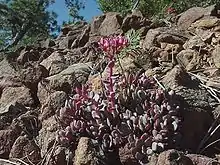| Sedum eastwoodiae | |
|---|---|
 | |
| Scientific classification | |
| Kingdom: | Plantae |
| Clade: | Tracheophytes |
| Clade: | Angiosperms |
| Clade: | Eudicots |
| Order: | Saxifragales |
| Family: | Crassulaceae |
| Genus: | Sedum |
| Species: | S. eastwoodiae |
| Binomial name | |
| Sedum eastwoodiae | |
| Synonyms[2] | |
|
Cotyledon mendocinoana Fedde | |
Sedum eastwoodiae is a rare species of flowering plant of the stonecrop Crassulaceae family.[2] It is known by its common name Red Mountain stonecrop. It is endemic to Mendocino County, California, where it is known from only four occurrences on Red Mountain, near Ukiah.[1][3] The total number of plants in existence is estimated to be around 5300.[1] They can be found on steep, exposed, rocky mountain slopes of serpentine substrate. This species has also been treated as a subspecies of Sedum laxum.[4]
Description
Sedum eastwoodiae is a small perennial succulent plant forming basal rosettes a few centimeters wide. The leaves are 1 to 3 centimeters long with the widest part near the distal end, then narrowing to a rounded or slightly notched tip. Smaller leaves occur farther up the stem. The foliage is blue-green in color, blushing reddish. The inflorescence is a spreading or flat-topped array of many small, star-shaped flowers with red or pink petals up to a centimeter long each, and stamens with red or purplish anthers.
Habitat
This species is known from a small section of habitat on a single mountain where the main potential threat to its existence is mining for nickel, chromium, and cobalt.[4]
References
- 1 2 3 The Nature Conservancy
- 1 2 "Sedum eastwoodiae (Britton) A.Berger". Plants of the World Online. The Trustees of the Royal Botanic Gardens, Kew. n.d. Retrieved August 22, 2020.
- ↑ California Native Plant Society Rare Plant Profile
- 1 2 USFWS. Species Assessment & Listing Priority Assignment Form. March, 2009.
